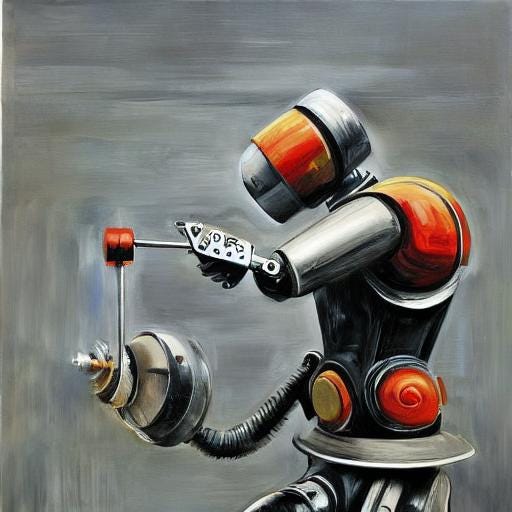Instruments of Success: Scaling AI Responsibly Through Software Support
A Values Canvas Case Study
This was a pretty big week for me.
On Monday, my book Responsible AI was released to the UK and world markets (for those of you in the US and Canada, my book releases on June 25th).
To say I am at a loss for words for what this milestone means to me is an understatement. So, instead I will let my own words speak for themselves today. In honor of my publishing month, I want to share an excerpt from my first chapter with you…
TL;DR - Read the Instrument case study here
An excerpt from Responsible AI: Implement an Ethical Approach in Your Organization:
“ I want to start with the story of the two carpenters. These aspiring carpenters were both new to the job, having just decided to take up the profession of carpentry. In order to learn the profession, they started apprenticeships with two different well known and respected carpentry teachers. Both teachers started the lessons from the basics, beginning with the simple task of hammering a nail into a block of wood.
The first aspiring carpenter was taught the exact action of how to hammer in the nail. The teacher took the hammer, showed the student the rounded end, and then took the nail and pointed out the flat top. The teacher then showed how to use the rounded end of the hammer to hit the flat top of the nail so that the pointed end of the nail would sink into the block of wood, taking special care to demonstrate the exact arm motions in detail. Once the first aspiring carpenter had memorized the specific action of hammering a nail into a block of wood, the teacher ended the lesson for the day.
Meanwhile, the second aspiring carpenter was taught about the hammer as a tool. Instead of showing the student how to hammer the nail, the second teacher spent the day explaining what makes a hammer a hammer. Going into excruciating detail, the teacher showed the student how the hammer is a tool designed to help a person use the laws of force to achieve different results. Never even picking up the nail or block of wood, the second teacher ended the lesson once they were satisfied that the second aspiring carpenter understood the whole entire hammer in full.
The next day the two aspiring carpenters returned for their next lessons. Deciding to test the students on what they had learned the day before, both teachers gave their students a hammer, a nail and a block of wood, and asked the students to hammer the nail into the wood. The first aspiring carpenter quickly picked up the hammer and, remembering the instructions from the day before, followed the exact actions necessary to hammer in the nail. The first teacher stood back and smiled with pride at how perfectly the student had followed instructions. The second aspiring carpenter was then given a hammer, nail and block of wood, and asked to complete the same task. Taking a moment to observe the hammer, the student recognized that they could use the rounded end of the hammer to apply force to the flat end of the nail and so sink it into the block of wood. The second teacher smiled as the student easily completed the task, having applied their knowledge of the hammer as a tool into action.
The second teacher then decided to issue a challenge, and asked both students to take their block of wood and now remove the nail that had been hammered into it. The first teacher watched in dismay as their student struggled to comprehend the task, flipping the block of wood over and trying to hit the nail out from the other side. Meanwhile the second student took a moment to look at the hammer, flipped it over in their hand, and easily popped the nail out of the block of the wood by using the forked end of the hammer as a tool to apply force to the nail in the opposite direction. The second teacher nodded in approval as the first teacher stood back, mouth agape with surprise.
Having only been taught the motion of hammering a nail into the wood, the first aspiring carpenter didn’t understand that the hammer had other potential uses. They had been taught one specific action, and although they had mastered that action, they did not know how to expand that knowledge into new domains. On the other hand, the second aspiring carpenter had not been taught a specific action, but instead had been taught all about the tool. With a deep understanding of the hammer in hand, the second carpenter was equipped to handle whatever task they were given with ease, as their knowledge of the hammer was not confined to only one action.
In this book, I am not going to teach you how to hammer a nail. Instead, I am going to show you everything you need to know about the hammer so that you are well equipped to handle whatever comes your way. ”
The third and final of the Process elements, this week we are covering the Instrument in the Values Canvas case studies series
The Values Canvas, a sneak peek into my book Responsible AI, is made up of three pillars: People, Process, and Technology. We’ve already covered the People pillar, with a look at its elements Educate, Motivate, and Communicate, as well as the first two elements of the Process Pillar, Intent and Implement, and so this week we move on to the third element, Instrument.
In this case study we are focusing tolling, specifically software, which is captured by the third Process element: Instrument.
In this element, we are looking to fill the need to standardize execution, automate processes where appropriate, and increase efficiency of Responsible AI practices at scale. An Instrument solution is any software used to standardize implementation of Responsible AI and ethics practices.
For this case study I had the honor of working with Yiannis Kanellopoulos, founder and CEO of code4thought, to dive into how his company’s software was used by Kepler Vision Technologies to build trust in AI for healthcare at scale.
To familiarize yourself with the Values Canvas and get a visual on the categories of case studies to come, download your very own open-access copy below, or get the book on how it all works.






